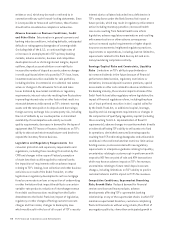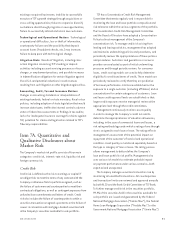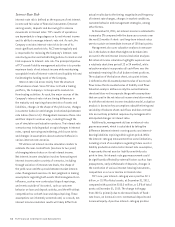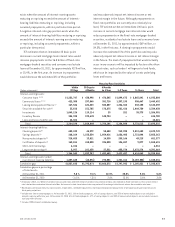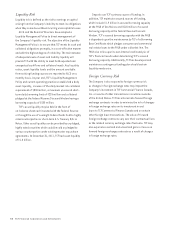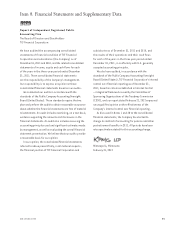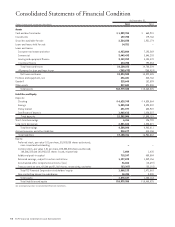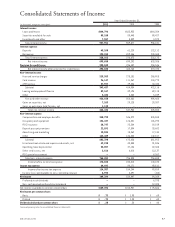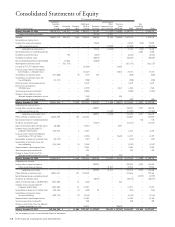TCF Bank 2011 Annual Report Download - page 66
Download and view the complete annual report
Please find page 66 of the 2011 TCF Bank annual report below. You can navigate through the pages in the report by either clicking on the pages listed below, or by using the keyword search tool below to find specific information within the annual report.Recent Accounting Developments
On April 29, 2011, the FASB issued Accounting Standards
Update (“ASU”) No. 2011-03, Reconsideration of Effective
Control for Repurchase Agreements (Topic 860), which
removes the collateral maintenance provision that is
currently required when determining whether a transfer of a
financial instrument is accounted for as a sale or a secured
borrowing. The adoption of the ASU will be required for TCF’s
Quarterly Report on Form 10-Q for the first quarter of 2012
and is not expected to have a material impact on TCF.
On May 12, 2011, the FASB issued ASU No. 2011-04,
Amendments to Achieve Common Fair Value Measurement
and Disclosure Requirements in U.S. GAAP and IFRS
(Topic 820), which is a joint effort between the FASB and
International Accounting Standards Board (“IASB”) to
converge fair value measurement and disclosure guidance.
The ASU permits measuring financial assets and liabilities
on a net credit risk basis, if certain criteria are met. The ASU
also increases disclosure surrounding company determined
fair values for level 3 financial instruments and also requires
the fair value hierarchy disclosure of financial assets
and liabilities that are not recognized at fair value in the
statement of financial position but included in disclosures
at fair value. The adoption of the ASU will be required for
TCF’s Quarterly Report on Form 10-Q for the first quarter of
2012 and is not expected to have a material impact on TCF.
On June 16, 2011, the FASB issued ASU No. 2011-05,
Presentation of Comprehensive Income (Topic 220),
which requires companies to report total net income,
each component of comprehensive income including
reclassifications between net income and other
comprehensive income, and total comprehensive income
on the face of the income statement, or as two consecutive
statements. The components of comprehensive income will
not be changed, nor does the ASU affect how earnings per
share is calculated or reported. These amendments will be
reported retrospectively upon adoption. The adoption of
the ASU will be required for TCF’s Quarterly Report on Form
10-Q for the first quarter of 2012 and is not expected to
have a material impact on TCF.
On December 16, 2011, the FASB issued ASU No. 2011-11,
Disclosures about Offsetting Assets and Liabilities
(Topic 210), which requires companies that have financial
and derivative instruments subject to a master netting
agreement to disclose the gross amount of the financial
assets and liabilities, the amounts that are offset on
the balance sheet, the net amounts presented, and the
amounts subject to a master netting arrangement that are
not offset. The adoption of the ASU will be required for TCF’s
Quarterly Report on Form 10-Q for the first quarter of 2013
and is not expected to have a material impact on TCF.
On December 23, 2011, the FASB issued ASU No. 2011-12,
Deferral of the Effective Date for Amendments to the
Presentation of Reclassifications of Items out of Accumulated
Other Comprehensive Income in Accounting Standards Update
No. 2011-05 (Topic 220), which defers the requirement within
ASU No. 2011-05 to present the reclassification amounts from
other comprehensive income to net income as a separate
component on the income statement. The FASB has not yet
established a new effective date for these provisions. The
remaining requirements of ASU No. 2011-05 were not deferred.
Fourth Quarter Summary
For the quarter ended December 31, 2011, TCF reported net
income of $16.4 million, compared with $33.9 million for
the quarter ended December 31, 2010. Diluted earnings
per common share was 10 cents for the quarter ended
December 31, 2011, compared with 24 cents for the quarter
ended December 31, 2010.
Net interest income was $173.4 million for the quarter
ended December 31, 2011, down $852 thousand, or .5%,
from the quarter ended December 31, 2010. The decrease
in net interest income was primarily due to the following
changes in loans and leases: reduced levels of higher
yielding fixed-rate consumer real estate loans and
decreases in leasing and equipment finance and commercial
real estate portfolio balances and average yields, partially
offset by reductions in average deposit rates. Net interest
margin for the quarter ended December 31, 2011 was 3.92%,
compared with 4.05% for the quarter ended December 31,
2010. The decrease in net interest margin was primarily due
to increased asset liquidity and decreased levels of higher
yielding loans and leases as a result of the lower interest
rate environment. These changes were partially offset by
a lower average cost of deposits and borrowings.
TCF provided $59.2 million for credit losses in the
quarter ended December 31, 2011, compared with $77.6
million in the quarter ended December 31, 2010. The
decrease was primarily due to decreased net charge-offs
and reserves in the commercial real estate and leasing
and equipment finance portfolios. For the quarter ended
December 31, 2011, net loan and lease charge-offs were
$57.9 million, or 1.63%, annualized, of average loans and
leases outstanding, compared with $64.9 million, or 1.75%,
annualized, of average loans and leases outstanding during
the quarter ended December 31, 2010. The decrease was
48 TCF Financial Corporation and Subsidiaries














